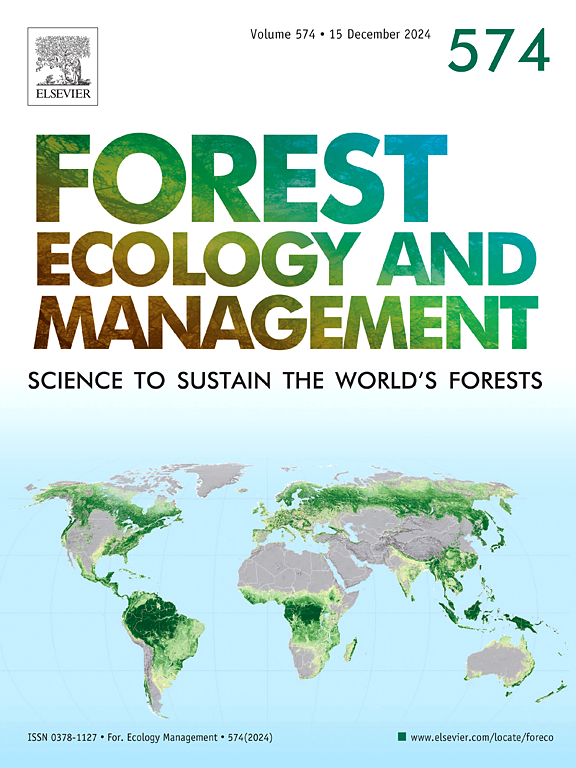磷胁迫破坏了热带云雾林的叶根性状关系并减少了生物量:来自两年磷添加实验的证据
IF 3.7
2区 农林科学
Q1 FORESTRY
引用次数: 0
摘要
土壤磷是热带森林中至关重要的限制性养分,影响植物形态和功能策略,从而影响森林的整体生产力。然而,迄今为止,大多数关于植物对磷肥反应的研究都只关注地上性状,很少有人知道地上和地下功能策略之间的权衡是如何受到影响的。为了弥补这一研究空白,我们在海南八王岭热带云雾林进行了为期两年(2022-2023)的原位磷肥试验。我们测试了施肥对幼树地上和地下功能性状的影响(1 cm≤DBH <;5 cm),属于5个优势树种。试验包括24个固定的10 × 10 m地块,处理包括不施肥对照和5个施磷量(1、2、4、8和16 g/m²yr−1);分别比较低磷(4 g/m²yr−1)、中磷(8 g/m²yr−1)和高磷(16 g/m²yr−1)处理。磷限制时,地上与地下资源利用性状(叶干质量与根干质量、叶表面积与根表面积、叶厚与比根长、比叶面积与比根长)呈负相关,表明磷胁迫导致地上与地下性状之间的权衡。增加磷显著增加了叶片叶绿素含量和总生物量,表明磷的限制限制了热带云雾林的碳同化和生物量生产。相反,叶片厚度、根干质量、根表面积、根体积和比根长等性状随着磷有效度的增加而普遍降低,这表明光合效率和地上生物量的增加是植物光合作用的重要组成部分。比较研究年份,我们发现根系性状对施肥的响应更快,地下性状在2022年比2023年响应更强烈,而地上性状则相反。虽然大多数群落加权平均性状在不同施磷处理之间变化不大,但存在物种特异性响应,表明施肥在物种水平上的影响大于群落水平。我们的研究结果强调,磷在塑造热带云雾林幼树的发展中起着重要作用,强调需要有针对性的管理方案来增强碳储存和生态系统稳定性,从而支持气候变化减缓努力。本文章由计算机程序翻译,如有差异,请以英文原文为准。
Phosphorus stress disrupts leaf-root trait relationships and reduces biomass in a tropical cloud forest: Evidence from a two-year phosphorus addition experiment
Soil phosphorus, a crucial limiting nutrient in tropical forests, shapes plant morphology and functional strategies, thereby affecting overall forest productivity. However, most research to date on plant responses to phosphorus fertilization has focused only on aboveground traits, and little is known as to how trade-offs between above- and below-ground functional strategies may be affected. To address this research gap, we conducted a two-year (2022–2023) in-situ phosphorus fertilization experiment, situated in the tropical cloud forest within Bawangling, Hainan Island, South China. We tested how fertilization affected both above- and below-ground functional traits in saplings (1 cm ≤ DBH < 5 cm) belonging to five dominant tree species. The experiment included 24 fixed 10 × 10 m plots, with treatments including an unfertilized control and five phosphorus application rates (1, 2, 4, 8, and 16 g/m² yr−1); low (4 g/m² yr−1), medium (8 g/m² yr−1), and high (16 g/m² yr−1) phosphorus treatments were individually compared. When phosphorus was limiting, we found negative correlations between above- and below-ground resource-use traits (e.g., leaf dry mass and root dry mass, leaf surface area and root surface area, leaf thickness and specific root length, and specific leaf area and specific root length), suggesting that phosphorus stress leads to trade-offs between above- and below-ground traits. Increasing phosphorus significantly increased the leaf chlorophyll content and total biomass, highlighting that phosphorus limitation constrains carbon assimilation and biomass production in tropical cloud forests. In contrast, traits such as leaf thickness, root dry mass, root surface area, root volume, and specific root length generally decreased as phosphorus availability increased, suggesting a shift toward greater photosynthetic efficiency and aboveground biomass production. Comparing study years, we found evidence that root traits responded faster to fertilization, with belowground traits responding more strongly in 2022 than 2023, while aboveground traits showed the opposite pattern. Although most community-weighted mean traits showed little variation among phosphorus treatments, species-specific responses were observed, suggesting that fertilization had a greater impact at the species versus community level. Our findings highlight that phosphorus plays a fundamental role in shaping sapling development in the tropical cloud forest, underlining the need for targeted management schemes to enhance carbon storage and ecosystem stability, thereby supporting climate change mitigation efforts.
求助全文
通过发布文献求助,成功后即可免费获取论文全文。
去求助
来源期刊

Forest Ecology and Management
农林科学-林学
CiteScore
7.50
自引率
10.80%
发文量
665
审稿时长
39 days
期刊介绍:
Forest Ecology and Management publishes scientific articles linking forest ecology with forest management, focusing on the application of biological, ecological and social knowledge to the management and conservation of plantations and natural forests. The scope of the journal includes all forest ecosystems of the world.
A peer-review process ensures the quality and international interest of the manuscripts accepted for publication. The journal encourages communication between scientists in disparate fields who share a common interest in ecology and forest management, bridging the gap between research workers and forest managers.
We encourage submission of papers that will have the strongest interest and value to the Journal''s international readership. Some key features of papers with strong interest include:
1. Clear connections between the ecology and management of forests;
2. Novel ideas or approaches to important challenges in forest ecology and management;
3. Studies that address a population of interest beyond the scale of single research sites, Three key points in the design of forest experiments, Forest Ecology and Management 255 (2008) 2022-2023);
4. Review Articles on timely, important topics. Authors are welcome to contact one of the editors to discuss the suitability of a potential review manuscript.
The Journal encourages proposals for special issues examining important areas of forest ecology and management. Potential guest editors should contact any of the Editors to begin discussions about topics, potential papers, and other details.
 求助内容:
求助内容: 应助结果提醒方式:
应助结果提醒方式:


